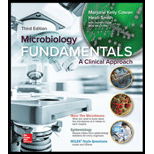
Microbiology Fundamentals: A Clinical Approach
3rd Edition
ISBN: 9781259709227
Author: Marjorie Kelly Cowan Professor, Heidi Smith
Publisher: McGraw-Hill Education
expand_more
expand_more
format_list_bulleted
Question
Chapter 14, Problem 8Q
Summary Introduction
To determine:
The reason as to why inducing plasma cells to secrete IgG instead of IgE prevents type I hypersensitivity.
Concept introduction:
Hypersensitivity is also referred to as intolerance. It refers to the undesirable reactions that are produced by the immune system. There are four types of hypersensitivities; type I (immediate), type II (antibody-dependent, cytotoxic), type III (immune complex disease), and type IV (delayed type).
Expert Solution & Answer
Want to see the full answer?
Check out a sample textbook solution
Students have asked these similar questions
Q8. A researcher wants to study the effectiveness of a pill intended to reduce stomach heartburn in pregnant
women. The researcher chooses randomly 400 women to participate in this experiment for 9 months of their
pregnancy period. They all need to have the same diet. The researcher designs two groups of 200 participants:
One group take the real medication intended to reduce heartburn, while the other group take placebo
medication. In this study what are:
Independent variable:
Dependent variable:
Control variable:
Experimental group: "
Control group:
If the participants do not know who is consuming the real pills and who is consuming the sugar pills.
This study is
It happens that 40% of the participants do not find the treatment helpful and drop out after 6 months.
The researcher throws out the data from subjects that drop out. What type of bias is there in this study?
If the company who makes the medication funds this research, what type of bias might exist in this
research work?
How do I determine the inhertiance pattern from the pedigree diagram?
its an open book assignemnt
Chapter 14 Solutions
Microbiology Fundamentals: A Clinical Approach
Ch. 14.1 - Define immunopathology, and identify the two major...Ch. 14.1 - Identify the four major categories of...Ch. 14.2 - Summarize genetic and environmental factors that...Ch. 14.2 - Identify three conditions caused by IgE-mediated...Ch. 14.2 - Identify the two clinical forms of anaphylaxis,...Ch. 14.2 - List the three main ways to prevent or...Ch. 14.2 - NCLEX PREP 1. During a visit to his physician, a...Ch. 14.2 - Prob. 2NPCh. 14.3 - List the three immune components causing cell...Ch. 14.3 - Prob. 8AYP
Ch. 14.4 - Prob. 9AYPCh. 14.4 - Medical Moment Patch Testing Patch testing is an...Ch. 14.5 - Prob. 10AYPCh. 14.5 - List four classes of grafts, and explain how host...Ch. 14.5 - NCLEX PREP 3. A patient receives a kidney...Ch. 14.6 - List at least three autoimmune diseases and the...Ch. 14.7 - Distinguish between primary and secondary...Ch. 14.7 - Medical Moment Hand Washing The importance of hand...Ch. 14.7 - Prob. 4NPCh. 14 - Allergy and atopy might have evolved in human...Ch. 14 - Can you think of a reason why humans have evolved...Ch. 14 - Prob. 3QCh. 14 - Prob. 4QCh. 14 - What feature of antibodies makes them particularly...Ch. 14 - Prob. 6QCh. 14 - Prob. 7QCh. 14 - Prob. 8QCh. 14 - Epi-pens are devices used to instantly inject a...Ch. 14 - Prob. 10QCh. 14 - Steroids administered to stop an allergic response...Ch. 14 - A very small number of people have a condition...Ch. 14 - Prob. 13QCh. 14 - Prob. 14QCh. 14 - Recent research shows that asthmatic patients have...Ch. 14 - Which statement is true of autoimmunity? a. It...Ch. 14 - It is often said that the normal microbiota of a...Ch. 14 - Investigate the link between Streptococcus...Ch. 14 - Which disease would be most similar to AIDS in its...Ch. 14 - Do you think people with B-cell deficiencies can...Ch. 14 - The chapter tells us that the gut microbiome of...Ch. 14 - Prob. 1VC
Knowledge Booster
Similar questions
- Describe two different gene regulation mechanisms involving methylationarrow_forwardWhat is behavioral adaptarrow_forward22. Which of the following mutant proteins is expected to have a dominant negative effect when over- expressed in normal cells? a. mutant PI3-kinase that lacks the SH2 domain but retains the kinase function b. mutant Grb2 protein that cannot bind to RTK c. mutant RTK that lacks the extracellular domain d. mutant PDK that has the PH domain but lost the kinase function e. all of the abovearrow_forward
- Explain how the hormones of the glands listed below travel around the body to target organs and tissues : Pituitary gland Hypothalamus Thyroid Parathyroid Adrenal Pineal Pancreas(islets of langerhans) Gonads (testes and ovaries) Placentaarrow_forwardWhat are the functions of the hormones produced in the glands listed below: Pituitary gland Hypothalamus Thyroid Parathyroid Adrenal Pineal Pancreas(islets of langerhans) Gonads (testes and ovaries) Placentaarrow_forwardDescribe the hormones produced in the glands listed below: Pituitary gland Hypothalamus Thyroid Parathyroid Adrenal Pineal Pancreas(islets of langerhans) Gonads (testes and ovaries) Placentaarrow_forward
arrow_back_ios
SEE MORE QUESTIONS
arrow_forward_ios
Recommended textbooks for you
 Human Biology (MindTap Course List)BiologyISBN:9781305112100Author:Cecie Starr, Beverly McMillanPublisher:Cengage Learning
Human Biology (MindTap Course List)BiologyISBN:9781305112100Author:Cecie Starr, Beverly McMillanPublisher:Cengage Learning Human Physiology: From Cells to Systems (MindTap ...BiologyISBN:9781285866932Author:Lauralee SherwoodPublisher:Cengage Learning
Human Physiology: From Cells to Systems (MindTap ...BiologyISBN:9781285866932Author:Lauralee SherwoodPublisher:Cengage Learning Biology (MindTap Course List)BiologyISBN:9781337392938Author:Eldra Solomon, Charles Martin, Diana W. Martin, Linda R. BergPublisher:Cengage Learning
Biology (MindTap Course List)BiologyISBN:9781337392938Author:Eldra Solomon, Charles Martin, Diana W. Martin, Linda R. BergPublisher:Cengage Learning Human Heredity: Principles and Issues (MindTap Co...BiologyISBN:9781305251052Author:Michael CummingsPublisher:Cengage Learning
Human Heredity: Principles and Issues (MindTap Co...BiologyISBN:9781305251052Author:Michael CummingsPublisher:Cengage Learning Concepts of BiologyBiologyISBN:9781938168116Author:Samantha Fowler, Rebecca Roush, James WisePublisher:OpenStax College
Concepts of BiologyBiologyISBN:9781938168116Author:Samantha Fowler, Rebecca Roush, James WisePublisher:OpenStax College

Human Biology (MindTap Course List)
Biology
ISBN:9781305112100
Author:Cecie Starr, Beverly McMillan
Publisher:Cengage Learning

Human Physiology: From Cells to Systems (MindTap ...
Biology
ISBN:9781285866932
Author:Lauralee Sherwood
Publisher:Cengage Learning

Biology (MindTap Course List)
Biology
ISBN:9781337392938
Author:Eldra Solomon, Charles Martin, Diana W. Martin, Linda R. Berg
Publisher:Cengage Learning


Human Heredity: Principles and Issues (MindTap Co...
Biology
ISBN:9781305251052
Author:Michael Cummings
Publisher:Cengage Learning

Concepts of Biology
Biology
ISBN:9781938168116
Author:Samantha Fowler, Rebecca Roush, James Wise
Publisher:OpenStax College